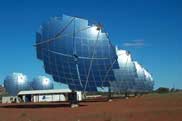A melbourne company is developing the world's first commercial plant using solar energy to make hydrogen gas — a clean fuel that can run cars or generate electricity, without producing greenhouse gases.
The $60 million project, based on an Australian breakthrough, aims to achieve science's elusive quest to convert solar energy into a fuel that can be stored and used when needed.
The developer, Solar Systems, of Hawthorn, is also building the $450 million Mildura solar power station due to start generating electricity in 2010. The solar hydrogen project will be attached to the power station or to a smaller demonstration power plant being built at Bridgewater, near Bendigo.
The project is possible because of technology developed by one of the company founders, John Lasich. In 1991 he discovered a new technique to perform electrolysis, the most common way of producing hydrogen gas, by passing an electric current through water.
He says this technology is now commercially feasible because it can be wed to a solar electricity plant, taking excess heat.
Mr Lasich says the project, which has backing from federal and state governments and private investors, will initially be a demonstration plant built over seven years, which will produce the equivalent of about one megawatt of power a day, when fully commissioned.
Storing power generated by clean means such as solar or wind is regarded as the Holy Grail of renewable energy.
Electrolysis is used to break down water into hydrogen and oxygen, but present technology is quite inefficient, even using solar power. At room temperature every 100 watts of electricity produces just 60 watts of hydrogen.
Mr Lasich's technique heats the water to 1000 degrees Celsius, a temperature at which the process delivers 140 watts worth of hydrogen for every 100 watts of electricity.
The plant will work by filtering off infra-red rays from sunlight hitting the cells of the solar power station.
The hydrogen would be stored and used to produce power after dark, by converting it directly to electricity through a fuel cell or reverse electrolysis, or using it to power a generator.
Several car makers have touted hydrogen as an alternative fuel to power engines. But supply problems with hydrogen have been a deterrent. Most hydrogen gas now produced is a byproduct of petroleum.
Mr Lasich believes that hydrogen fuel can be produced for a similar price to petrol.
"If it is used in a car specially designed to run on it, its higher flame temperature means it is about 30 per cent more efficient than petrol," he says.
"This technology is a byproduct of our solar power station, we have developed it as something we can roll off the end once we get the power station up and running.
"We think that once we demonstrate it on a commercial scale, in the current climate there will be global demand."

